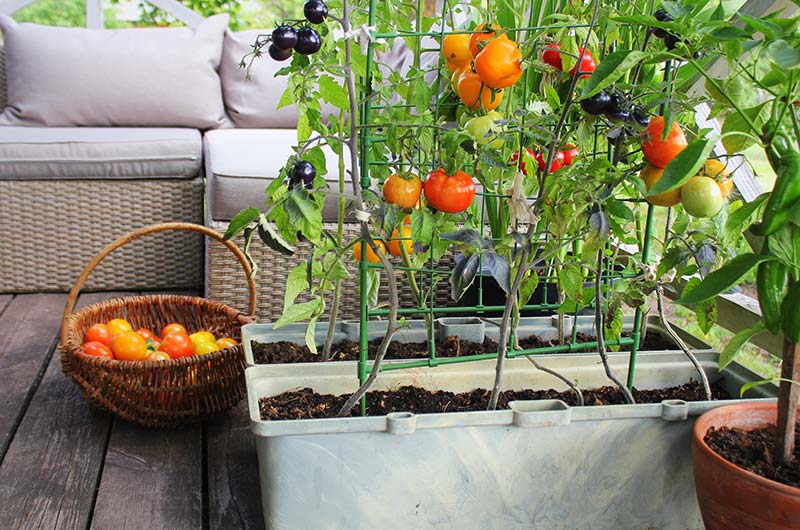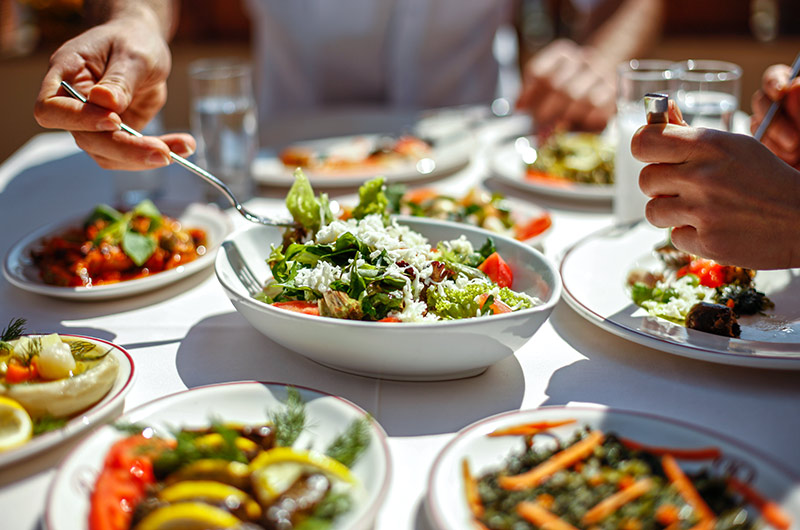How To Grow Your Own Food
Wondering if you can grow your own food? The answer is yes — and you don't have to be a gardener or have any type of plant-growing experience. With desire, determination and a few food-growing basics, you can start growing food today. With Pennington as your partner and these tips on how to grow food, you'll be on your way:
- Why Grow Your Own Food
- Where You Can Grow Food
- How to Start Food Plants
- What Foods You Can Grow
- How to Care for Food Crops
Why Grow Your Own Food
Growing your own food yields more rewards than just tasty produce and fun times with dirt. These are some of the benefits that prove growing your own food is worth the effort:
- Nutrition – Homegrown fruits and vegetables, picked at the peak of ripeness, are more nutritious than supermarket versions picked early and then shipped in, or kept in storage.1 (And homegrown tastes better, too.)
- Selection – Growing your own food means more choices, especially when you grow from seeds. Rather than choosing whatever your local market has, you decide what varieties you want to eat.
- Savings – Depending on what you grow, homegrown food can cut your food expenses significantly.2 A single zucchini plant can yield enough squash to feed family, friends and neighbors, too.
- Sustainability – Forget about long-distance trucking and deliveries. When you grow your own food, you are the supply chain. And the carbon footprint from garden to table is impressively low.
- Control – When you grow your own food you know everything that goes into it, from the hands that touch it to the fertilizers that feed it, from planting to home-cooked meals.

You can grow food on a terrace or a plot of land.
Where You Can Grow Your Own Food
Vegetables and other crops are more adaptable than many people realize. From urban high-rises to country hills, there are plenty of options for where to grow:
- Gardens – Outdoor gardens come in all sizes, from a square foot of soil to school gardens and community plots. In-ground gardens are excellent for growing and harvesting vegetables. The expanse of soil protects against heat and drought, but outdoor plantings are more exposed to animals and pests.
- Containers – Limited to a patio or balcony? You can still enjoy homegrown vegetables and other container-grown food. Even blueberry bushes grow well in pots. As a general rule, the bigger the pot, the better for food plants. Be aware that soil dries out much faster in containers than in outdoor, in-ground gardens, so container plants need extra attention and more frequent watering.
- Indoors – Many edible flowers, herbs and vegetables flourish indoors in windows or under lights. You can even grow an indoor lemon tree or a from-your-own-seed avocado plant.
Whether you're growing organic vegetables outdoors or windowsill wheatgrass, make sure your growing space provides three essentials:
- Sufficient soil – Vigorous roots need plenty of room to grow. Carrots, for example, need pots at least 8 inches deep. Tomatoes, blueberries and container citrus trees prefer containers 12 to 24 inches deep and wide.
- Excellent drainage – Robust fruits and veggies don't tolerate soggy soil. Avoid low-lying areas for in-ground gardens. Make sure containers have good drainage holes.
- Abundant light – Most produce does best with at least six to eight hours of daily sun. More is better when it comes to growing food. If you're short on sunshine indoors, supplemental lighting helps.

Transplants are a great way to start tomatoes and other heat-loving plants.
How to Start Food Plants
Once you decide what to grow, it's time to dig in. You can start from scratch with seeds or get a head start with plants:
- Seeds – With some online research, you can find seeds for almost any plant you want to eat. Seed are relatively inexpensive, but you'll wait longer for outdoor harvests. If you plan ahead, you can start vegetable seeds indoors, then transplant indoor vegetables outdoors and shorten the wait.
- Transplants – Also known as starter plants, these young plants offer faster harvests, but you're limited to what nurseries or garden centers choose to grow.
- Mature plants – Depending on your growing goals, ready-to-harvest plants may be your style. Container citrus trees and patio tomato plants are often sold this way.
If you're growing food outdoors, make sure your area's growing season lasts long enough that your seeds or transplants reach the eating stage before fall frost arrives.3 Don't have a clue what's normal in your area? That's okay. Give your local county extension office a call.
For hot-weather food plants that need a long growing season — like tomatoes and eggplants — starter plants are a wise choice. Give transplants a boost with Pennington Plant Starter. It provides valuable micronutrients and reduces transplant shock.

Strawberry plants grow well in hanging baskets, pots and outdoors.
What Foods You Can Grow
Timed right and treated well, a wide variety of foods can be grown inside or outside your home:
- Vegetables – Many vegetables grow easily from garden-planted seed. These include tatsoi, arugula and other leafy greens, as well as snow peas, purple carrots, golden beets and prolific squash.
- Fruits – Kumquats, lemons and limes all have container-friendly varieties that grow well inside homes. Botanically speaking, tomatoes are fruits, too. Given the right conditions, they grow almost anywhere.
- Berries – Antioxidant-rich blueberries, blackberries and raspberries grow well outdoors, but some varieties were bred for containers. Hungry for strawberries? They'll even grow in hanging baskets.
Always follow the directions on your seed packets or plant tags. Some plants, such as lettuce, can tolerate cool air and soil temperatures. But others, like zucchinis, can't take the cold.4 For cool-weather crops — think kale, cabbages and tender greens — you can enjoy early harvests, then plant vegetables for a fall harvest, too.

The best part of growing your own food is enjoying the fruits of your labor.
How to Care for Food Crops
Proper care translates to healthy food plants and bountiful harvests. Plant nutrition is especially important, so take time to understand fertilizer labels. Many food plants have similar needs, so you can optimize effort and minimize maintenance:
- Watering – Fruits and vegetables need plentiful water to form properly, ripen fully and draw nutrients from soil. Ensure your plants get water equal to about 1 inch of weekly precipitation, including natural rainfall. Container plants may need daily doses.
- Weeding – Weeds can pop up unannounced, even in containers indoors. Weeds steal water and nutrients meant for your food plants, so pull them out immediately.
- Fertilizing – Nutrient-rich veggies and fruits need quality nutrients as they grow. By feeding your plants according to their needs and your goals, you'll enjoy bigger, better fruits and vegetables.
- Protecting - Insects love to feed on outdoor fruits and vegetables. Apply Sevin Insect Killer Ready-to-Use at the first sign of insect damage. The spray kills on contact but will not harm your edibles.
For premium all-round nutrition, Pennington Rejuvenate Plant Food All Purpose 4-4-4 delivers a balanced blend of fast-acting and slow-release ingredients that keep plants well-fed for up four months. Specialty fertilizers, matched to your food type, provide targeted nutrition.
Pennington Rejuvenate Plant Food Citrus and Avocado 5-3-4 promotes delicious citrus fruits. Pennington UltraGreen Citrus and Avocado Plant Food 10-5-5 gives trees the nutritional foundation for plant vigor and productivity.
For ongoing support throughout the growing season, time-proven Alaska Fish Fertilizer 5-1-1, listed by the Organic Materials Review Institute (OMRI), gently nourishes your growing food.
By following this simple road map, you can enjoy all the benefits of growing your own food — including sharing your harvest with family and friends. With premium products and educational resources, Pennington is here for you. Let us help you learn, grow and enjoy.
Always read product labels thoroughly and follow instructions, including guidelines for pre-harvest intervals (PHI) and application frequency for edible crops.
Pennington is a registered trademark of Pennington Seed, Inc.
Alaska, Lilly Miller and UltraGreen are registered trademarks of Central Garden & Pet Company.
GardenTech is a registered trademark of Gulfstream Home and Garden, Inc.
Sevin is a registered trademark of Tessenderlo Kerley, Inc.
Resources
1. M. Lussier, "5 Reasons to Grow Your Own Food," University if New Hampshire, 2018.
2. National Gardening Association, "Get Healthy and Save Money by Food Gardening."
3. A. Steil, "Vegetable Harvest Guide," Iowa State University Extension, 2004.
4. J.F. Harrington, "Soil Temperature Conditions for Vegetable Seed Germination," University of California-Davis.




